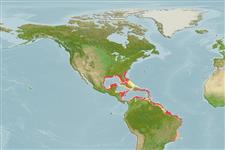Environment: milieu / climate zone / depth range / distribution range
Ecología
marino asociado a arrecife; rango de profundidad 0 - 75 m (Ref. 5217), usually 18 - ? m (Ref. 51183). Tropical; 33°N - 23°S, 98°W - 34°W (Ref. 34024)
Western Atlantic: North Carolina, USA and northern Gulf of Mexico to southeastern Brazil. Absent from the Bahamas.
Tamaño / Peso / Age
Maturity: Lm ? range ? - ? cm
Max length : 30.0 cm TL macho / no sexado; (Ref. 7251); common length : 23.0 cm TL macho / no sexado; (Ref. 5217)
Short description
Morfología | Morfometría
Head and body tan, unmarked except for dark margin to dorsal fin and, occasionally, anal fin; gill raker on first arch with 2 rudiments on upper limb; dorsal profile nearly straight from snout to dorsal-fin origin (not arched); body distinctly deepest at dorsal-fin origin; body slab-sided (Ref. 34024).
A common species ranging from coastal bays to 75 m depth (Ref. 34024). Inhabit soft bottoms (Ref. 5217). Oviparous, with oval pelagic eggs floating in a gelatinous mass (Ref. 205). Flesh is appreciated (Ref. 5217).
Life cycle and mating behavior
Madurez | Reproducción | Puesta | Huevos | Fecundidad | Larva
Nielsen, J.G., D.M. Cohen, D.F. Markle and C.R. Robins, 1999. Ophidiiform fishes of the world (Order Ophidiiformes). An annotated and illustrated catalogue of pearlfishes, cusk-eels, brotulas and other ophidiiform fishes known to date. FAO Fish. Synop. 125(18):178p. Rome: FAO. (Ref. 34024)
IUCN Red List Status (Ref. 130435)
Threat to humans
Harmless
Human uses
Pesquerías: escaso valor comercial
Más información
Age/SizeCrecimientoLength-weightLength-lengthLength-frequenciesMorfometríaMorfologíaLarvaDinámica larvariaReclutamientoAbundanciaBRUVS
ReferenciasAcuiculturaPerfil de acuiculturaRazasGenéticaElectrophoresesheritabilidadEnfermedadesProcesamientoNutrientsMass conversion
Herramientas
Special reports
Download XML
Fuentes de Internet
Estimates based on models
Preferred temperature (Ref.
123201): 23.2 - 27.9, mean 25.7 °C (based on 202 cells).
Phylogenetic diversity index (Ref.
82804): PD
50 = 0.5000 [Uniqueness, from 0.5 = low to 2.0 = high].
Bayesian length-weight: a=0.00257 (0.00122 - 0.00544), b=3.17 (2.99 - 3.35), in cm total length, based on LWR estimates for this (Sub)family-body shape (Ref.
93245).
Nivel trófico (Ref.
69278): 3.6 ±0.7 se; based on size and trophs of closest relatives
Resiliencia (Ref.
120179): Alto, población duplicada en un tiempo mínimo inferior a 15 meses (Preliminary K or Fecundity.).
Fishing Vulnerability (Ref.
59153): Low vulnerability (20 of 100).
Nutrients (Ref.
124155): Calcium = 65.9 [37.4, 107.1] mg/100g; Iron = 0.702 [0.430, 1.171] mg/100g; Protein = 16.8 [14.3, 19.4] %; Omega3 = 0.114 [0.069, 0.203] g/100g; Selenium = 37.5 [20.7, 78.1] μg/100g; VitaminA = 124 [44, 327] μg/100g; Zinc = 1.16 [0.82, 1.60] mg/100g (wet weight);
